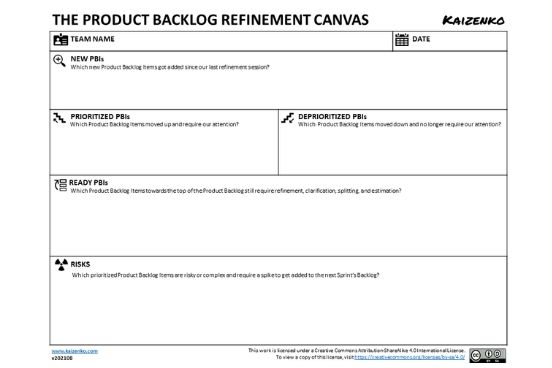Use the Product Backlog Refinement Canvas as a template to help you and your team run effective refinement sessions.
The Scrum Guide defines Product Backlog Refinement as the act of breaking down and further defining Product Backlog items into smaller more precise items. This is an ongoing activity to add details, such as a description, order, and size.
Check out these 6 tips for improving your product backlog refinement sessions, and remember that refinement is a collaborative activity done with the Developers. Use the Product Backlog Refinement Canvas to guide you through your meeting.
New Product Backlog Items

Start by discussing what new user stories got added to the product backlog. Provide enough context around them in terms of why they got added or what triggered their addition, and where they currently fall in the product backlog.
Prioritized Product Backlog Items

Next, move on to discuss which PBIs moved up the Product Backlog. These items might require additional attention and discussion due to their importance. We might also want to provide an initial estimate to identify possible risks (see risks below).
Deprioritized Product Backlog Items
Next, mention the user stories that moved down the Product Backlog or got removed all together. These are the stories that got deprioritized and are no longer important. We do not need to worry about them anymore. Discuss the impact this might have on items that are in progress or that were already completed.
“Ready” Product Backlog Items

The bulk of our time in Product Backlog Refinement is spent on preparing the top of the Product Backlog to ensure it is “ready” for the upcoming Sprint. Address any remaining user stories that still require refinement, clarification, splitting, estimation or sizing. There should be no major surprises once we get to Sprint Planning. The user stories towards the top have gone through multiple refinement sessions as they moved up the Product Backlog, each time adding details as needed and acceptance criteria based on questions raised by the Developers. The stories have been broken up into small valuable vertical slices of end to end functionality and are properly sized to fit in the Sprint.
Risks

Finally, identify and discuss any Product Backlog Items are risky or complex and might require a spike to get added to the next Sprint’s Backlog to run a short timeboxed research activity to increase our learnings, reduce the complexity and mitigate the risks as we prep the item for further discussions in future refinement sessions.
Click here to download a pdf template of the Product Backlog Refinement Canvas.
